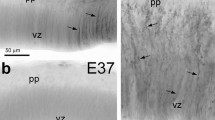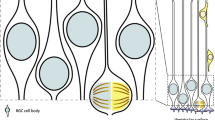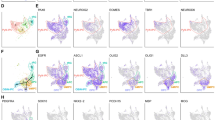Abstract
During brain development, radial glial (RG) cells and the different progenitor subtypes are characterized by their bipolar morphology that includes an ovoid cell body and one or two radial processes that span across the developing cerebral wall. Different cells transport the reduced form of vitamin C, ascorbic acid (AA), using sodium-dependent ascorbic acid cotransporters (SVCT1 or SVCT2). SVCT2 is mainly expressed in the nervous system (CNS); however, its localization in the central nervous system during embryonic development along with the mechanism by which RG take up vitamin C and its intracellular effects is unknown. Thus, we sought to determine the expression and localization of SVCT2 during CNS development. SVCT2 is preferentially localized in the RG body at the ventricular edge of the cortex during the neurogenic stage (E12 to E17). The localization of SVCT2 overexpressed by in utero electroporation of E14 embryos is consistent with ventricular polarization. A similar distribution pattern was observed in human brain tissue sections at 9 weeks of gestation; however, SVCT2 immunoreaction was also detected in the inner and outer subventricular zone (SVZ). Finally, we used C17.2 neural stem cell line, J1ES cells and primary cell cultures derived from the brain cortex to analyze functional SVCT2 activity, AA effects in progenitor cells bipolar morphology, and SVCT2 expression levels in different culture conditions. Our results indicate that basal RG cells and apical intermediate and subapical progenitors are the main cell types expressing SVCT2 in the lissencephalic brain. SVCT2 was mainly detected in the apical region of the ventricular zone cells, contacting the cerebrospinal fluid. In gyrencephalic brains, SVCT2 was also detected in progenitor cells located in the inner and outer SVZ. Finally, we defined that AA has a strong radializing (bipolar morphology) effect in progenitor cells in culture and the differentiation condition modulates SVCT2 expression.












Similar content being viewed by others
Abbreviations
- AA:
-
Ascorbic acid
- DHA:
-
Dehydroascorbic acid
- DMEM:
-
Dulbecco’s modified Eagle medium
- FBS:
-
Fetal bovine serum
- DOG:
-
deoxyglucose
- GFAP:
-
Glial fibrillary acidic protein
- GLUT:
-
Glucose transporter
- IMDM:
-
Iscove’s Modified Dulbecco’s medium
- NSC:
-
Neural stem cell
- PAGE:
-
Polyacrylamide gel electrophoresis
- PBS:
-
Phosphate–buffered saline
- RG:
-
Radial glia
- SVCT:
-
Sodium-dependent ascorbic acid cotransporters
- SDS:
-
Sodium dodecyl sulfate
- VZ:
-
Ventricular zone.
References
Gray GE, Sanes JR (1992) Lineage of radial glia in the chicken optic tectum. Development 114:271–283
Noctor SC, Flint AC, Weissman TA, Dammerman RS, Kriegstein AR (2001) Neurons derived from radial glial cells establish radial units in neocortex. Nature 409:714–720
Noctor SC, Flint AC, Weissman TA, Wong WS, Clinton BK, Kriegstein AR (2002) Dividing precursor cells of the embryonic cortical ventricular zone have morphological and molecular characteristics of radial glia. J Neurosci 22:3161–3173
Noctor SC, Martinez-Cerdeno V, Ivic L, Kriegstein AR (2004) Cortical neurons arise in symmetric and asymmetric division zones and migrate through specific phases. Nat Neurosci 7:136–144
Gotz M, Hartfuss E, Malatesta P (2002) Radial glial cells as neuronal precursors: a new perspective on the correlation of morphology and lineage restriction in the developing cerebral cortex of mice. Brain Res Bull 57:777–788
Anthony TE, Klein C, Fishell G, Heintz N (2004) Radial glia serve as neuronal progenitors in all regions of the central nervous system. Neuron 41:881–890
Miller FD, Gauthier AS (2007) Timing is everything: making neurons versus glia in the developing cortex. Neuron 54:357–369
Bentivoglio M, Mazzarello P (1999) The history of radial glia. Brain Res Bull 49:305–315
Leprince P, Chanas-Sacre G (2001) Regulation of radial glia phenotype. Prog Brain Res 132:13–22
Hartfuss E, Galli R, Heins N, Gotz M (2001) Characterization of CNS precursor subtypes and radial glia. Dev Biol 229:15–30
Nadarajah B, Brunstrom JE, Grutzendler J, Wong RO, Pearlman AL (2001) Two modes of radial migration in early development of the cerebral cortex. Nat Neurosci 4:143–150
Nadarajah B, Alifragis P, Wong RO, Parnavelas JG (2002) Ventricle-directed migration in the developing cerebral cortex. Nat Neurosci 5:218–224
Campbell K (2005) Cortical neuron specification: it has its time and place. Neuron 46:373–376
Dehay C, Kennedy H (2007) Cell-cycle control and cortical development. Nat Rev Neurosci 8:438–450
Noctor SC, Palmer SL, Hasling T, Juliano SL (1999) Interference with the development of early generated neocortex results in disruption of radial glia and abnormal formation of neocortical layers. Cereb Cortex 9:121–136
Corbin JG, Gaiano N, Juliano SL, Poluch S, Stancik E, Haydar TF (2008) Regulation of neural progenitor cell development in the nervous system. J Neurochem 106:2272–2287
Keilani S, Sugaya K (2008) Reelin induces a radial glial phenotype in human neural progenitor cells by activation of notch-1. BMC Dev Biol 8:69
Gotz M, Huttner WB (2005) The cell biology of neurogenesis. Nat Rev Mol Cell Biol 6:777–788
Paridaen JT, Huttner WB (2014) Neurogenesis during development of the vertebrate central nervous system. EMBO Rep 15:351–364
Tyler WA, Haydar TF (2013) Multiplex genetic fate mapping reveals a novel route of neocortical neurogenesis, which is altered in the Ts65Dn mouse model of Down syndrome. J Neurosci 33:5106–5119
Fietz SA, Kelava I, Vogt J, Wilsch-Brauninger M, Stenzel D, Fish JL, Corbeil D, Riehn A, Distler W, Nitsch R, Huttner WB (2010) OSVZ progenitors of human and ferret neocortex are epithelial-like and expand by integrin signaling. Nat Neurosci 13:690–699
Hansen DV, Lui JH, Parker PR, Kriegstein AR (2010) Neurogenic radial glia in the outer subventricular zone of human neocortex. Nature 464:554–561
Reillo I, de Juan RC, Garcia-Cabezas MA, Borrell V (2011) A role for intermediate radial glia in the tangential expansion of the mammalian cerebral cortex. Cereb Cortex 21:1674–1694
Garcia-Krauss A, Ferrada L, Astuya A, Salazar K, Cisternas P, Martinez F, Ramirez E, Nualart F (2015) Dehydroascorbic acid promotes cell death in neurons under oxidative stress: a protective role for astrocytes. Mol Neurobiol
Rice ME (2000) Ascorbate regulation and its neuroprotective role in the brain. Trends Neurosci 23:209–216
Esteban MA, Wang T, Qin B, Yang J, Qin D, Cai J, Li W, Weng Z, Chen J, Ni S, Chen K, Li Y, Liu X, Xu J, Zhang S, Li F, He W, Labuda K, Song Y, Peterbauer A, Wolbank S, Redl H, Zhong M, Cai D, Zeng L, Pei D (2010) Vitamin C enhances the generation of mouse and human induced pluripotent stem cells. Cell Stem Cell 6:71–79
Nualart F, Mack L, Garcia A, Cisternas P, Bongarzone ER, Heitzer M, Jara N, Martinez F, Ferrada L, Espinoza F, Baeza V, Salazar K (2014) Vitamin C transporters, recycling and the bystander effect in the nervous system: SVCT2 versus gluts. J Stem Cell Res Ther 4:209
Ulloa V, Garcia-Robles M, Martinez F, Salazar K, Reinicke K, Perez F, Godoy DF, Godoy AS, Nualart F (2013) Human choroid plexus papilloma cells efficiently transport glucose and vitamin C. J Neurochem 127:403–414
Spector R, Johanson CE (2014) The nexus of vitamin homeostasis and DNA synthesis and modification in mammalian brain. Mol Brain 7:3
Wang H, Dutta B, Huang W, Devoe LD, Leibach FH, Ganapathy V, Prasad PD (1999) Human Na(+)-dependent vitamin C transporter 1 (hSVCT1): primary structure, functional characteristics and evidence for a non-functional splice variant. Biochim Biophys Acta 1461:1–9
Wang Y, Mackenzie B, Tsukaguchi H, Weremowicz S, Morton CC, Hediger MA (2000) Human vitamin C (L-ascorbic acid) transporter SVCT1. Biochem Biophys Res Commun 267:488–494
Faaland CA, Race JE, Ricken G, Warner FJ, Williams WJ, Holtzman EJ (1998) Molecular characterization of two novel transporters from human and mouse kidney and from LLC-PK1 cells reveals a novel conserved family that is homologous to bacterial and Aspergillus nucleobase transporters. Biochim Biophys Acta 1442:353–360
Daruwala R, Song J, Koh WS, Rumsey SC, Levine M (1999) Cloning and functional characterization of the human sodium-dependent vitamin C transporters hSVCT1 and hSVCT2. FEBS Lett 460:480–484
Rajan DP, Huang W, Dutta B, Devoe LD, Leibach FH, Ganapathy V, Prasad PD (1999) Human placental sodium-dependent vitamin C transporter (SVCT2): molecular cloning and transport function. Biochem Biophys Res Commun 262:762–768
Tsukaguchi H, Tokui T, Mackenzie B, Berger UV, Chen XZ, Wang Y, Brubaker RF, Hediger MA (1999) A family of mammalian Na+-dependent L-ascorbic acid transporters. Nature 399:70–75
Liang WJ, Johnson D, Jarvis SM (2001) Vitamin C transport systems of mammalian cells. Mol Membr Biol 18:87–95
Castro M, Caprile T, Astuya A, Millan C, Reinicke K, Vera JC, Vasquez O, Aguayo LG, Nualart F (2001) High-affinity sodium-vitamin C co-transporters (SVCT) expression in embryonic mouse neurons. J Neurochem 78:815–823
Castro MA, Pozo M, Cortes C, Garcia Mde L, Concha II, Nualart F (2007) Intracellular ascorbic acid inhibits transport of glucose by neurons, but not by astrocytes. J Neurochem 102:773–782
Garcia Mde L, Salazar K, Millan C, Rodriguez F, Montecinos H, Caprile T, Silva C, Cortes C, Reinicke K, Vera JC, Aguayo LG, Olate J, Molina B, Nualart F (2005) Sodium vitamin C cotransporter SVCT2 is expressed in hypothalamic glial cells. Glia 50:32–47
Qiu S, Li L, Weeber EJ, May JM (2007) Ascorbate transport by primary cultured neurons and its role in neuronal function and protection against excitotoxicity. J Neurosci Res 85:1046–1056
Mun GH, Kim MJ, Lee JH, Kim HJ, Chung YH, Chung YB, Kang JS, Hwang YI, Oh SH, Kim JG, Hwang DH, Shin DH, Lee WJ (2006) Immunohistochemical study of the distribution of sodium-dependent vitamin C transporters in adult rat brain. J Neurosci Res 83:919–928
Nualart F, Salazar K, Oyarce K, Cisternas P, Jara N, Silva-Alvarez C, Pastor P, Martinez F, Garcia A, Garcia-Robles Mde L, Tapia JC (2012) Typical and atypical stem cells in the brain, vitamin C effect and neuropathology. Biol Res 45:243–256
Pastor P, Cisternas P, Salazar K, Silva-Alvarez C, Oyarce K, Jara N, Espinoza F, Martinez AD, Nualart F (2013) SVCT2 vitamin C transporter expression in progenitor cells of the postnatal neurogenic niche. Front Cell Neurosci 7:119
Salazar K, Martinez M, Ulloa V, Bertinat R, Martinez F, Jara N, Espinoza F, Bongarzone ER et al (2015) SVCT2 overexpression in neuroblastoma cells induces cellular branching that is associated with ERK signaling. Mol Neurobiol
Rose RC (1988) Transport of ascorbic acid and other water-soluble vitamins. Biochim Biophys Acta 947:335–366
Carr A, Frei B (1999) Does vitamin C act as a pro-oxidant under physiological conditions? FASEB J 13:1007–1024
Padayatty SJ, Levine M (2001) New insights into the physiology and pharmacology of vitamin C. CMAJ 164:353–355
Hediger MA (2002) New view at C. Nat Med 8:445–446
Lee JY, Chang MY, Park CH, Kim HY, Kim JH, Son H, Lee YS, Lee SH (2003) Ascorbate-induced differentiation of embryonic cortical precursors into neurons and astrocytes. J Neurosci Res 73:156–165
Kratzing CC, Kelly JD, Oelrichs BA (1982) Ascorbic acid in neural tissues. J Neurochem 39:625–627
Milby K, Oke A, Adams RN (1982) Detailed mapping of ascorbate distribution in rat brain. Neurosci Lett 28:169–174
Terpstra M, Gruetter R (2004) 1H NMR detection of vitamin C in human brain in vivo. Magn Reson Med 51:225–229
Kratzing CC, Kelly JD, Kratzing JE (1985) Ascorbic acid in fetal rat brain. J Neurochem 44:1623–1624
Caprile T, Salazar K, Astuya A, Cisternas P, Silva-Alvarez C, Montecinos H, Millan C, de Los Angeles Garcia M, Nualart F (2009) The Na+-dependent L-ascorbic acid transporter SVCT2 expressed in brainstem cells, neurons, and neuroblastoma cells is inhibited by flavonoids. J Neurochem 108:563–577
Nualart F, Godoy A, Reinicke K (1999) Expression of the hexose transporters GLUT1 and GLUT2 during the early development of the human brain. Brain Res 824:97–104
Salazar K, Cerda G, Martinez F, Sarmiento JM, Gonzalez C, Rodriguez F, Garcia-Robles M, Tapia JC, Cifuentes M, Nualart F (2014) SVCT2 transporter expression is post-natally induced in cortical neurons and its function is regulated by its short isoform. J Neurochem 130:693–706
Rio C, Rieff HI, Qi P, Khurana TS, Corfas G (1997) erbB receptors Neuregulin and play a critical role in neuronal migration. Neuron 19:39–50
Hatten ME (1985) Neuronal regulation of astroglial morphology and proliferation in vitro. J Cell Biol 100:384–396
Colombo JA, Napp MI (1996) In vitro induction of radial-like cells by leptomeningeal and cortical astroglial conditioned media. Effect of protease inhibitors. Int J Dev Neurosci 14:489–496
Liour SS, Yu RK (2003) Differentiation of radial glia-like cells from embryonic stem cells. Glia 42:109–117
Nualart FJ, Rivas CI, Montecinos VP, Godoy AS, Guaiquil VH, Golde DW, Vera JC (2003) Recycling of vitamin C by a bystander effect. J Biol Chem 278:10128–10133
Miyata T, Kawaguchi A, Okano H, Ogawa M (2001) Asymmetric inheritance of radial glial fibers by cortical neurons. Neuron 31:727–741
Yamasaki M, Yamada K, Furuya S, Mitoma J, Hirabayashi Y, Watanabe M (2001) 3-phosphoglycerate dehydrogenase, a key enzyme for l-serine biosynthesis, is preferentially expressed in the radial glia/astrocyte lineage and olfactory ensheathing glia in the mouse brain. J Neurosci 21:7691–7704
Snyder EY, Deitcher DL, Walsh C, Arnold-Aldea S, Hartwieg EA, Cepko CL (1992) Multipotent neural cell lines can engraft and participate in development of mouse cerebellum. Cell 68:33–51
Song J, Kwon O, Chen S, Daruwala R, Eck P, Park JB, Levine M (2002) Flavonoid inhibition of sodium-dependent vitamin C transporter 1 (SVCT1) and glucose transporter isoform 2 (GLUT2), intestinal transporters for vitamin C and glucose. J Biol Chem 277:15252–15260
Chanas-Sacre G, Thiry M, Pirard S, Rogister B, Moonen G, Mbebi C, Verdiere-Sahuque M, Leprince P (2000) A 295-kDA intermediate filament-associated protein in radial glia and developing muscle cells in vivo and in vitro. Dev Dyn 219:514–525
Liour SS, Kraemer SA, Dinkins MB, Su CY, Yanagisawa M, Yu RK (2006) Further characterization of embryonic stem cell-derived radial glial cells. Glia 53:43–56
Goodman T, Hajihosseini MK (2015) Hypothalamic tanycytes-masters and servants of metabolic, neuroendocrine, and neurogenic functions. Front Neurosci 9:387
Rodriguez EM, Blazquez JL, Pastor FE, Pelaez B, Pena P, Peruzzo B, Amat P (2005) Hypothalamic tanycytes: a key component of brain-endocrine interaction. Int Rev Cytol 247:89–164
Boyer JC, Campbell CE, Sigurdson WJ, Kuo SM (2005) Polarized localization of vitamin C transporters, SVCT1 and SVCT2, in epithelial cells. Biochem Biophys Res Commun 334:150–156
Subramanian VS, Marchant JS, Reidling JC, Said HM (2008) N-glycosylation is required for Na+-dependent vitamin C transporter functionality. Biochem Biophys Res Commun 374:123–127
Varma S, Campbell CE, Kuo SM (2008) Functional role of conserved transmembrane segment 1 residues in human sodium-dependent vitamin C transporters. Biochemistry 47:2952–2960
Varma S, Sobey K, Campbell CE, Kuo SM (2009) Hierarchal contribution of N- and C-terminal sequences to the differential localization of homologous sodium-dependent vitamin C transporters, SVCT1 and SVCT2, in epithelial cells. Biochemistry 48:2969–2980
Jin SN, Mun GH, Lee JH, Oh CS, Kim J, Chung YH, Kang JS, Kim JG, Hwang DH, Hwang YI, Shin DH, Lee WJ (2005) Immunohistochemical study on the distribution of sodium-dependent vitamin C transporters in the respiratory system of adult rat. Microsc Res Tech 68:360–367
Wu H, Wu Y, Ai Z, Yang L, Gao Y, Du J, Guo Z, Zhang Y (2014) Vitamin C enhances Nanog expression via activation of the JAK/STAT signaling pathway. Stem Cells 32:166–176
Acknowledgments
This work was supported by grants from the Fondo Nacional de Ciencia y Tecnología (FONDECYT 1140477 FN, 11130529 to CSA, 11140405 to KS, 11150678 to FM) and Conicyt-PIA CMA BIO BIO ECM-12 to FN. We thank Dra. Marjet Heitzer for critically reading and editing the manuscript and Ms. Ximena Koch for the technical support.
Author information
Authors and Affiliations
Corresponding author
Ethics declarations
Ethical Statement
All animals were handled in strict accordance with the Animal Welfare Assurance (permit number 2010101A), and all animal work was approved by the appropriate Ethics and Animal Care and Use Committee of the University of Concepcion, Chile.
Conflict of Interest
The authors declare that they have no conflict of interest.
Rights and permissions
About this article
Cite this article
Silva-Álvarez, C., Salazar, K., Cisternas, P. et al. Apical Polarization of SVCT2 in Apical Radial Glial Cells and Progenitors During Brain Development. Mol Neurobiol 54, 5449–5467 (2017). https://doi.org/10.1007/s12035-016-0081-2
Received:
Accepted:
Published:
Issue Date:
DOI: https://doi.org/10.1007/s12035-016-0081-2




